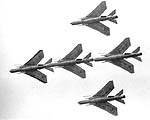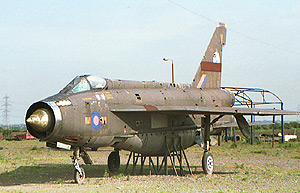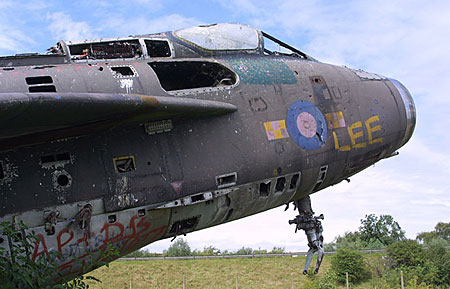Home | Airshows | The Hangar | Nostalgia | Links
Gary Parsons tells the tale of an A1 milestone
She stands alone on a piece of empty waste ground, proudly pointing to the sky where she feels she belongs. A waypoint on the A1 for nearly twenty years, she is a familiar sight for many enthusiasts en-route to Waddington from the southern counties. But, time and man are taking their toll, as bit-by-bit she disappears through the actions of decay and souvenir hunters.
|
92
and the F2
|
|
No 92 Squadron was founded at London Colney on 1 September 1917 as a scout squadron. Early in 1963 some of 92's pilots began the Lightning Conversion Squadron course at Middleton St George on Teeside before returning to their home base at RAF Leconfield in Yorkshire for further training on the based T4s. The first F2 (XN783) arrived on 26 March and was swiftly coded 'A'. Several more F2s followed in April to enable 92 to begin conversion training in earnest, but it wasn't until late June that the squadron received its full complement of aircraft. |
 |
| Operational status soon followed and air refuelling practise took place the following year. Also in 1964 92 Squadron was accorded the privilege of being appointed the official Fighter Command Aerobatics team, succeeding the 'Firebirds' of 56 Squadron. On 29 December 1964 92 Squadron left Leconfield for RAF Geilenkirchen in Western Germany, but its stay was relatively brief as another move was made in early 1968 to join 19 Squadron at RAF Gutersloh - it was deemed more economical to operate all the Germany-based Lightnings from one base. RAF Geilenkirchen was finally closed on 28 January 1968 with flying operations ceasing that same day. |
|
Finale
|
| 92 Squadron Lightnings adopted the dark olive green camouflage from 1972 until the conclusion of their operational service on 1 April 1977, after which several remained in use a decoys at Gutersloh and other RAF airfields in Germany and the UK. |
Lightning
F2A XN728/V (c/n 95105) was built during 1961 at English Electric's Samlesbury
facility. She first flew on 26 October of that year, piloted by test pilot
T. M. S. Ferguson, and was issued to 92 Squadron at RAF Leconfield on
1 April 1963 (it isn't clear what she did in the intervening eighteen
months). She was to spend her whole career with 92 Squadron, initially
coded 'B', later  'F'
and finally 'V'. Her career was unremarkable, except for an undercarriage
collapse on 3 April 1968, during the repair of which she was converted
to F2A standard, basically a Mk6 but still retaining her guns. 31 of the
original 44 F2s were converted from 1968 onwards - the engines were upgraded
to the Avon RA211R but the armament fit was retained. External features
were the most noticeable, comprising the cambered wing, square-cut fin
and much enlarged ventral tank of the F6. XN728 went on to serve the RAF
in Germany until 92 Squadron disbanded in March 1977, prior to re-equipping
with the Phantom FGR2. She then
'F'
and finally 'V'. Her career was unremarkable, except for an undercarriage
collapse on 3 April 1968, during the repair of which she was converted
to F2A standard, basically a Mk6 but still retaining her guns. 31 of the
original 44 F2s were converted from 1968 onwards - the engines were upgraded
to the Avon RA211R but the armament fit was retained. External features
were the most noticeable, comprising the cambered wing, square-cut fin
and much enlarged ventral tank of the F6. XN728 went on to serve the RAF
in Germany until 92 Squadron disbanded in March 1977, prior to re-equipping
with the Phantom FGR2. She then  made
her final flight to RAF Coningsby where she served as a decoy aircraft
for a number of years with the maintenance serial 8546M.
made
her final flight to RAF Coningsby where she served as a decoy aircraft
for a number of years with the maintenance serial 8546M.
On 3 October 1983 she was purchased by G.A. Wilks, and transferred to the yard of A1 Commercial Vehicles in Balderton, near Newark. The method of transfer was brutal, the wings and tail being cut near the root, so that she would not be able to support herself once put back together - a trestle support, placed under the ventral belly tank, kept her properly poised once at the yard. The wings and tail were re-attached using large metal plates, which sadly went unpainted and proved to be a bit of an eyesore.
|
As
she is today
|
 |
 |
 |
 |
 |
 During
the nineties the vehicle yard fell on hard times and eventually closed,
falling into disrepair. Being so close to Newark, anything that had a
tangible value was swiftly removed (including the fence) and XN728 eventually
became abandoned and alone, available for the attention of anyone wandering
by. Removal of the wheels and the radar radome hurried the collapse of
the ventral tank, causing the now tail-heavy aircraft to settle back into
her present attitude, as if clawing to get airborne once more. Attacked
by vandals and graffiti 'artists', she remains more as testimony to man's
wanton desire for destruction, rather than a proud sentinel of the Cold
War in which she played a major part at the sharpest end. How long will
During
the nineties the vehicle yard fell on hard times and eventually closed,
falling into disrepair. Being so close to Newark, anything that had a
tangible value was swiftly removed (including the fence) and XN728 eventually
became abandoned and alone, available for the attention of anyone wandering
by. Removal of the wheels and the radar radome hurried the collapse of
the ventral tank, causing the now tail-heavy aircraft to settle back into
her present attitude, as if clawing to get airborne once more. Attacked
by vandals and graffiti 'artists', she remains more as testimony to man's
wanton desire for destruction, rather than a proud sentinel of the Cold
War in which she played a major part at the sharpest end. How long will
 she
last? How long before some do-gooder proclaims she is a danger to those
idiots that vandalise her? She may well be beyond salvation by an interested
museum, more's the pity. But, she'll live on in many an enthusiast's living
room, being one of the options in Airfix's recently released 1/48 scale
model - who'll be brave enough to replicate 2002's condition?
she
last? How long before some do-gooder proclaims she is a danger to those
idiots that vandalise her? She may well be beyond salvation by an interested
museum, more's the pity. But, she'll live on in many an enthusiast's living
room, being one of the options in Airfix's recently released 1/48 scale
model - who'll be brave enough to replicate 2002's condition?
Home | Airshows | The Hangar | Nostalgia | Links
